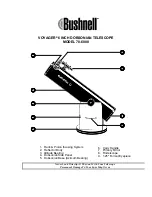
TELESCOPE ASSEMBLY INSTRUCTIONS
1. Your telescope has adjustable (telescoping) legs (Fig. 1).
2. Stand tripod and spread legs. Loosen the three leg clamps. Grab tripod head and lift.
Extend the tripod legs to the desired height (at equal lengths) and tighten the clamps
on each leg to hold it in position (Fig. 1). Note: please tighten tripod head bolts after
removing from box, as some vibration during shipment may have loosened them.
3. Attach the accessory tray (P) to the center leg braces on the tripod legs (Fig 2) and
insert accessory tray and bolt through center of tray into braces and tighten bolt.
4. Remove telescope main body from the box. Attach telescope main body (H) by aligning
the hole in the telescope saddle with that in the yoke. Screw yoke locking knobs (L)
through both holes and tighten the knob.
5. Remove the finderscope (G) from the box. Remove the two knurled thumbscrews from
the telescope main body. Position the finderscope bracket on the telescope main body so
that the holes in the base of the bracket line up with the exposed bolts in the telescope
main body. Replace the two-knurled thumbscrews and tighten securely (Fig. 3).
6. Insert eyepiece (E) into focus tube (C). Secure by tightening small retaining screw.
NOTE: In all astronomical telescopes, the image appears upside down. To use the
telescope for terrestrial view and to correct the mirrored image, insert the erecting
eyepiece in between the focus tube (C) and the eyepiece (E). We recommend the use
of the low magnification eyepiece when the telescope is used for terrestrial viewing.
Reflectors (mirrors) are used mainly for astronomical purposes.
The telescope is now fully assembled and ready for use.
7. To use the Barlow, insert Barlow (Fig. 5) into the focus tube. Secure by tightening small
retaining screw. Insert eyepiece into open end of Barlow and secure.
8. To use the erecting lens, insert erecting lens (Fig. 5) into the focus tube. Secure by
tightening small retaining screw. Insert eyepiece into the open end of the erecting lens
and secure. This will allow you to view objects naturally on land—not upside down or
backwards.
TO USE THE FINDERSCOPE
The finderscope is a small wide field of view telescope mounted alongside the main
telescope and is used to search for the target and aim the main telescope at it. But before
you can use the finderscope, you will need to line it up with the telescope. This procedure
will become easier with practice.
1. Install the lowest power eyepiece (25mm) into the eyepiece tube. Pick out an easily
recognized, unmoving object no closer than a thousand yards away. Aim your telescope
toward your object until its image is centered in the eyepiece. Lock all the knobs on the
mount so the telescope will not move.
2. Look through the finderscope. If the object you lined up in the telescope is not visible,
adjust the two adjustment screws and move the finderscope around until you see it.
3. Recheck your telescope to make certain it is still on target. If it moved, realign it and
adjust your finderscope. If it hasn’t, you’re all set. Your finderscope is now operational.
QVC 78-6114 Telescope 1LIM.indd 5
9/6/2006 3:02:26 PM





















